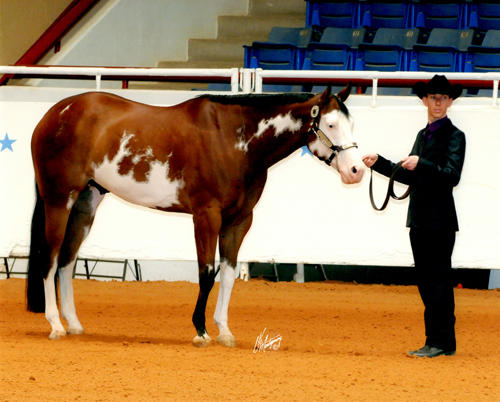
Christopher Strong and All Time Favorite
To excel at Showmanship a horse and exhibitor team must do a lot more than correctly execute each maneuver in the pattern. It is demonstrating an ability to move as one with the horse.
“Showmanship is like a dance,” says Christopher Strong, of Shoreview, Minnesota, the 2011 and 2012 Pinto World Grand Champion in Western Showmanship, “you have to be 100 percent coordinated with your horse.”
With fewer elements than Trail or Horsemanship, Showmanship encourages handlers to develop their own style to differentiate themselves from other competitors.
“I like that you get to add your own style to the pattern,” says Sarah Miller, of Boulder, Colorado, who finished in the Top 10 in both the AQHA and NSBA Youth Showmanship 15-18 classes and third in both the NYATT and NYATT NSBA at the 2014 All-American Quarter Horse Congress. “You also get to show how athletic you and your horse are in different parts of the pattern.”
Eugene, “Gene”, Spagnola an AQHA Professional Horseman who trains out of Powder Brook Farm in Harwinton, Connecticut, said, “a well-designed Showmanship pattern is one that allows individuals to demonstrate their connection with their horse on the ground. A commendable pattern flows from one maneuver to another with ease and precision.”
Though Showmanship requires precision, it may be the most inviting event for competitors new to breed shows.
“I consider Showmanship an introductory class to association shows,” says Terry Cross of Dry River Ranch in Weatherford, Texas and an AQHA Professional Horseman with AQHA and NSBA judging cards.
“At the higher levels there is a separation of ability, but when an exhibitor is just starting out anyone who walks into the ring has a chance to do well. You don’t have to own the most expensive horse to have success in Showmanship,” he adds.
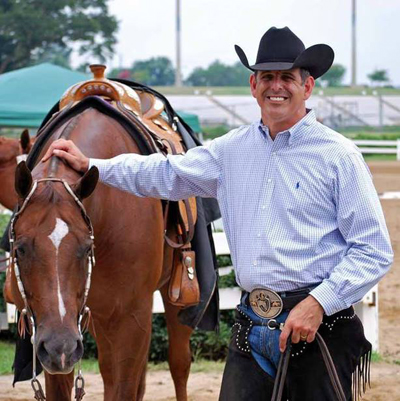
Gene Spagnola
The Evolution of Showmanship
Whether you’re a seasoned Showmanship competitor or a rookie learning to master the class, chances are you’ve wondered how a judge or show committee develops the pattern you are asked to perform.
To understand how Showmanship patterns are created it’s important to recognize how the class came to be. Showmanship evolved out of halter classes.
A decade ago, the class was based on how well one presented their horse for halter. All exhibitors were in the arena at the same time and completed a short pattern. The judge(s) completed individual walk-around inspections.
“A handler’s ability to show a halter horse wasn’t enough for judges to separate exhibitors as the level of competitiveness evolved,” Cross says.
Nowadays, patterns are prescribed and are run individually. “Today judges are able to enhance the complexity of their patterns. It is much more than showing a horse at halter, but rather demonstrating one’s ability to convey their effortless partnership with their horse,” Spagnola explains.
Despite being complex, the patterns are not necessarily designed to be “tricky.” The patterns Rhonda Replogle, of Rhonda Replogle Show Horses in Clear Spring, Maryland, designs as a carded judge for AQHA, APHA, NRCHA, NSBA and the International Buckskin Horse Association, are intended to be user friendly and not as an effort to exclude or weed out exhibitors.
“I design patterns where everyone has a fair chance at completing the pattern,” she says.
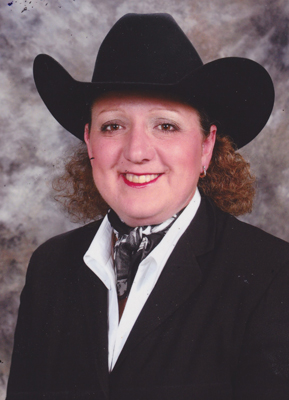
Rhona Replogle
That being said, she considers each specific show and the exhibitor completing the pattern.
“In a Select class I would not ask exhibitors for an extended trot for 90 miles around the arena,” she says.
Introductory and/or weekend shows may dictate patterns with a lesser degree of difficulty, but it is all based on the experience level of the attendees.
Regardless of the show, a Showmanship pattern typically includes a walk, jog, extended jog, turn-around/pivot, back-up and a set-up. The variety in patterns is in the order the maneuvers are strung together.
“Everyone thinks these horses are robots,” Replogle says, “for example, turns need to be thrown in different places instead of always at the end.”
The variety keeps horses fresh and showable longer.
“Not that I am an expert by any means I just love to design patterns…but I think the elements other than the normal turn, and set up are the important ones. You can really show off that you have the degree of difficulty in maneuvering,” says Shelly DeBarbanson, APHA’s Director of Youth and Amateur Activities, who designs patterns for APHA events.
Lines, specifically straight lines, are Replogle’s go-to design element.
“I include either a straight line to the judge or a straight line backing away from me with a turn,” she says. “Executing a straight line is more difficult than it seems. People have to know where the judge or the cone is located, be totally lined up and make sure they exhibit to that point.”
Depending on the show, judges are able to design their own course or may be given one chosen/designed by the show committee. In many cases, Replogle draws her own patterns. Over her nearly three decade career she has assembled a book of patterns she works from, making adjustments based on the event she’s judging.
“Some of the patterns I use are borrowed from other judges because I like the smoothness of the pattern and how it is exhibited,” she adds.
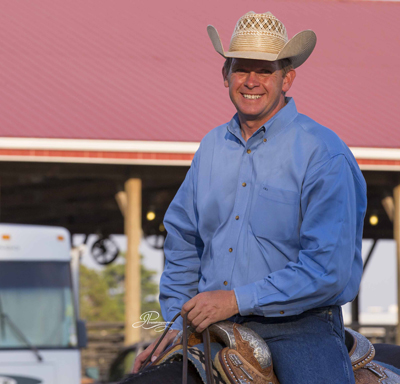
Terry Cross
Conversely, Cross usually judges a pattern designed by someone else. “The show committee, one of the other judges or one of David Denniston’s patterns from Horseshowpatterns.com is used,” he says, “we don’t always have the option of designing our own.”
Chad Evans, an AQHA Professional Horseman from Boulder, Colorado, and judge for AQHA and NSBA, admits it varies by event. On some occasions he’s creating his own pattern, while at other events, he is provided one.
“I prefer patterns with a good back-up,” he says, “where, (the back-up) especially at the speed at which it is done, shows me how much work an exhibitor has done with their horse.”
When Evans isn’t judging, he’s attending shows as a competitor and trainer.
“Sometimes I wonder if the pattern is enough to challenge exhibitors,” he says, “however I recognize the most talented exhibitor can take a simple pattern and make it really good.”
Spagnola believes current Showmanship patterns are hitting the mark, allowing exhibitors to demonstrate their skills. However, “one problem that I have is that distances in the pattern are often set way too short. As a consequence, this creates a lack of flow and one’s ability to show their horse off,” he explains.
Tina Langness of Tina Langness Performance Horses in New Richmond, Wisconsin agrees.
“Judges and pattern designers need to be fully aware of the pattern they chose, study it and know that you have given the exhibitor enough room to perform the maneuvers well,” she said, “all exhibitors should have the same working advantage.
That means if you have a 15.1 hand western horse or a 17.2 hand English horse, you are given plenty of room to perform the patterns.”
Spagnola also prefers patterns with backup distances longer than a horse length, or four steps.
“Most horses, if trained properly, are able to back a horse length with adequate speed and cadence, but as the maneuver increases in the number of steps, a judge has a much easier time establishing the horse that has a stronger backup from those with a weaker, average backup,” he explains.
As the class continues to evolve the degree of difficulty will continue to go up. “There comes a point when you ask yourself, how much further can this go? Our exhibitors and horses are so talented these days,” Langness says, “with having so many good to excellent exhibitors it comes down to the style the judge most prefers.”
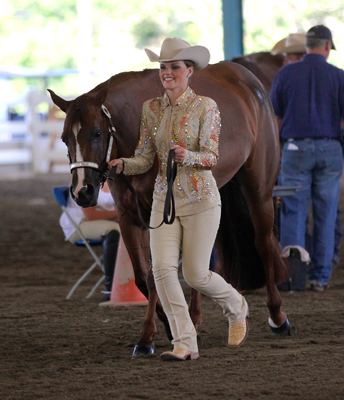
Sarah Miller
Practice makes perfect
There’s no avoiding it–practice makes perfect. Striving to perfect the small details is critical. The tiny “bobbles” are the ones that drop a score quickly.
“Most exhibitors look past the basic pivot, but there always seems to be mistakes,” Langness says, “what looks like a simple task is not necessarily easy.”
Sliding a pivot foot or picking it up and placing it back down in the same place is a minor fault. Picking up a pivot foot and placing it in a different spot is considered a major fault.
“So as you can see it’s the small things that whittle away at your score,” she explains.
Mastering the set-up can be equally difficult. “I always struggle with the set-up because it is different every time we stop and I never know which foot I will have to move or how much it has to move,” Miller says.Repetition is the only remedy. “We practice the set-up separately and then as part of a larger pattern at home,” she adds.
Quality practice is even more important than repetition. “Find a qualified instructor or coach to watch you practice,” Evans suggests, “even asking a friend to video a practice session so you can watch yourself is helpful.”
Beyond drilling each maneuver, exhibitors should be conscientious of hitting their marks. Replogle, who judged at the 2014 All-American Congress, was shocked at the number of competitors missing their marks.
“There were a lot of good people who missed their marks, even in the big amateur class,” she emphasizes, “missing a cone or a mark in Showmanship is just like a Reiner or Western Riding competitor missing a cone.”
Making the mark demonstrates a handler’s “feel” for their horse. “Exhibitors need to develop a connection to the horse,” Evans explains, “a connection means the exhibitor understands the horse’s rhythm and where in a horse’s stride they can ask for a back-up, turn, etc.”
Confidence is an important component of Showmanship.
“A lot of exhibitors lack it in the beginning,” Cross says, “they feel it’s a beauty contest and it’s not.” A polished appearance is important, but it’s time spent with the horse and a confidence in one’s ability to perform that is most important.”
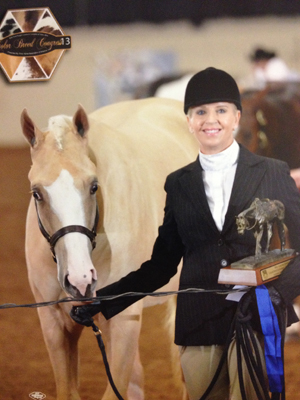
Tina Langness
Show Time
Prior to stepping into the show pen, exhibitors should read their association rulebook.
“The handbook outlines the rules and regulations and lays out the guidelines for how we judge,”Replogle says.
Once an exhibitor understands how they will be evaluated by the judge(s) it’s time to memorize the pattern. Committing a pattern to memory is more than reviewing the diagram.
“First I read the pattern (diagram). Then I read what’s outlined so that I can understand the words and pictures together,” Strong explains.
Next, Strong visualizes how he will complete the pattern.
“In my head I walk through how my horse and I will complete the pattern before I even practice it with my horse,” he explains.
Lastly, he breaks the pattern down into pieces that he knows will give him the most trouble and schools those individually.
Miller agrees that visualizing the pattern helps prepare for an upcoming class.
“After I memorize the order, I run through the pattern in my head and think of the things I have to do with my horse to make it (the pattern) successful,” she adds.
Finally, schooling in the practice pen, specifically the spots that will be most challenging for you and your horse, allows you to prepare for the upcoming performance.
“I never really do an entire pattern over and over again,” Strong said, “instead I tune up individual transitions or movements.”
The final moments leading up to a class can be nerve-wracking.
“It’s easy to tell a person to breathe or try to relax,” Langness notes, “but we all know most of us are no good at that.”
Instead she encourages her clients to channel their nerves into positive thoughts.
“It’s good to be a little nervous and anxious, it’s what can really help draw out your best performance,” she adds.
When it’s finally your moment in the spotlight, “keep yourself natural, poised, confident and don’t be afraid to create your own style—you never know, you could be the next trendsetter,” Langness concludes.


You must be logged in to post a comment Login